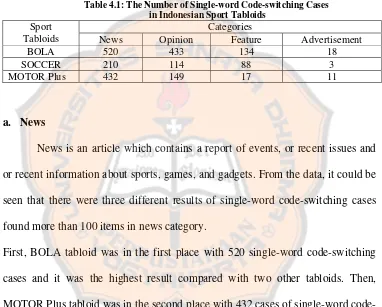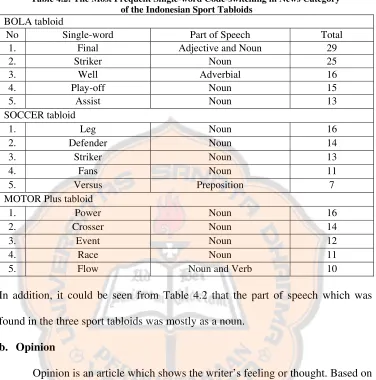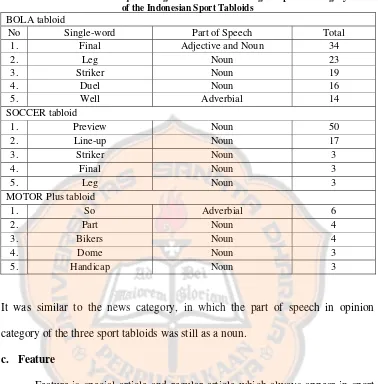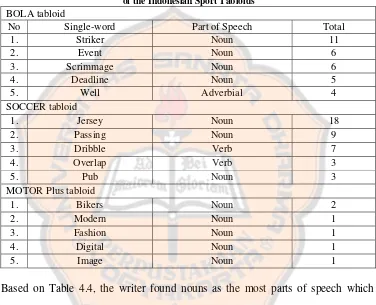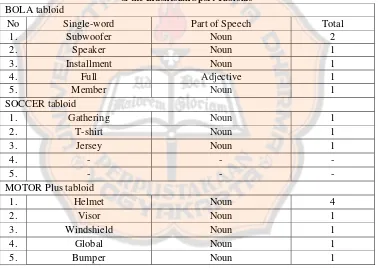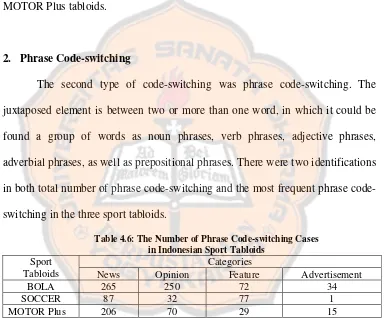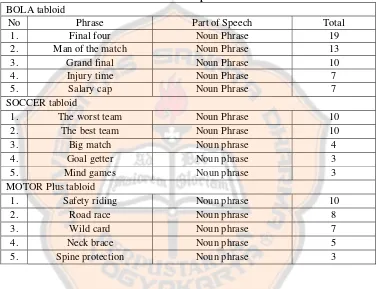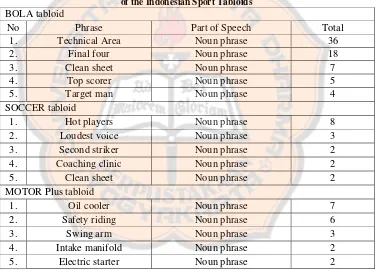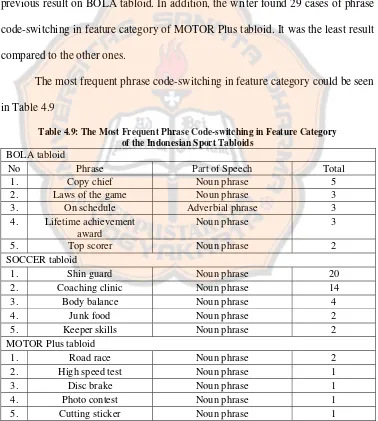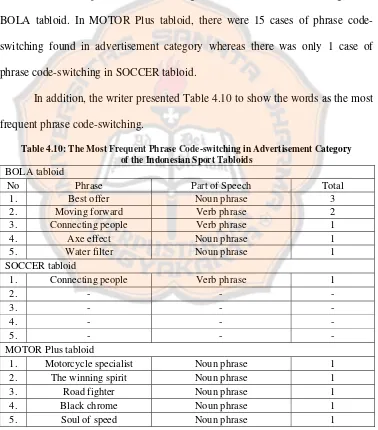ENGLISH CODE-SWITCHING IN INDONESIAN SPORT TABLOIDS
A THESIS
Presented as Partial Fulfillment of the Requirements to Obtain the Sarjana Pendidikan Degree
in English Language Education
By
Fidelis Windiawan Adhi Purnomo Student Number: 051214031
ENGLISH LANGUAGE EDUCATION STUDY PROGRAM DEPARTMENT OF LANGUAGE AND ARTS EDUCATION FACULTY OF TEACHERS TRAINING AND EDUCATION
SANATA DHARMA UNIVERSITY YOGYAKARTA
i
ENGLISH CODE-SWITCHING IN INDONESIAN SPORT TABLOIDS
A THESIS
Presented as Partial Fulfillment of the Requirements to Obtain the Sarjana Pendidikan Degree
in English Language Education
By
Fidelis Windiawan Adhi Purnomo Student Number: 051214031
ENGLISH LANGUAGE EDUCATION STUDY PROGRAM DEPARTMENT OF LANGUAGE AND ARTS EDUCATION FACULTY OF TEACHERS TRAINING AND EDUCATION
SANATA DHARMA UNIVERSITY YOGYAKARTA
iv
STATEMENT OF WORK’S ORIGINALITY
I honestly declare that this thesis, which I have written, does not contain the work or parts of the work of other people, except those cited in the quotations and the references, as a scientific paper should.
Yogyakarta, 23 June 2009
The Writer
v
LEMBAR PERNYATAAN PERSETUJUAN
PUBLIKASI KARYA ILMIAH UNTUK KEPENTINGAN AKADEMIS
Yang bertanda tangan di bawah ini, saya mahasiswa Universitas Sanata Dharma:
Nama : Fidelis Windiawan Adhi Purnomo
Nomor Mahasiswa : 051214031
Demi pengembangan ilmu pengetahuan, saya memberikan kepada Perpustakaan Universita Sanata Dharma karya ilmiah saya yang berjudul
English Code-switching in Indonesian Sport Tabloids
Dengan demikian saya memberikan kepada Perpustakaan Universitas Sanata Dharma hak untuk menyimpan, mengalihkan dalam bentuk media lain, mengelolanya dalam bentuk pangkalan data, mendistribusikan secara terbatas, dan mempublikasikannya di Internet atau media lain untuk kepentingan akademis tanpa perlu meminta ijin dari saya maupun memberikan royalty kepada saya selama tetap mencantumkan nama saya sebagai penulis.
Demikian pernyataan ini saya buat dengan sebenarnya.
Dibuat di Yogyakarta Pada tanggal: 22 Juni 2009 Yang menyatakan
vi
ACKNOWLEDGMENTS
I would like to thank Jesus Christ for giving me strength and guiding me all the time in my life. I thank Him for making me free of the fears and the pains during this exhausting process. He is such a zephyr that keeps whispering me the meaningful
reasons why I have to finish my study well. In addition, I also would like to express my gratitude to those who have supported me.
First, I would like to thank F.X Ouda Teda Ena, S.Pd., M.Pd.,my sponsor, especially for his guidance, suggestions, corrections, support, and patience in the process of completing my thesis. May God always be with him ever after.
Second, I would like to thank all the lecturers and staff of English Education Study Program, Sanata Dharma University, who have patiently taught and given the
best to me from the beginning till the end of my study. I thank them for giving me a lot of knowledge and experiences for my brighter future.
Furthermore, I would like to express my deepest gratitude to my beloved
parents, FX. Trihadi & Fr. Sri Purwanti Wahyuningsih, for all their prayer, support, understanding, encouragement and anything that I got so far. My special
vii
My sincerely gratitude is addressed to my thesis-mates, Vinsensia Tyas Maharsi, Desideria Araya, Emanuella Swastika Datu, Roomawardi, Koko Adityanto, and Anastasia Permata Liska for their togetherness and sharing to finish the thesis.
Last but not least, I would like to thank all my best friends inside or outside
English Education Study Program, especially Agustinus Wahyu Wasono Putro, Andreas Jeffry Okavianto, Bondan R. Subagya, Ezra Anggara Y., Agatha Pepy Y., Esti Dewanti, Fillomena Tunjung, Daniel Ari W., Pius Rahardian Putranto, Yosaphat Dwi Santo N., SEC members, UKMK members,and PENDOPO mass media members.I thank them for their care, support, encouragement, and being with me all the time. Remember that life is beautiful!
I specially would like to thank Gendis Naskoshi & Paulus Yanu Armanto for loving me all the time. Both of them are so special in my life.
viii
TABLE OF CONTENTS
Page
TITLE PAGE ………
PAGES OF APPROVAL………
STATEMENT OF WORK’S ORIGINALITY ……… LEMBAR PERNYATAAN PERSETUJUAN PUBLIKASI KARYA ILMIAH
ACKNOWLEDGMENTS………
TABLE OF CONTENTS ………
LIST OF TABLES ……….
LIST OF APPENDICES ………
ABSTRACT ………...
ABSTRAK………..
CHAPTER I: INTRODUCTION
A. Research Background ………
B. Problem Formulation ………..
C. Problem Limitation ………
D. Research Objectives ………...
E. Research Benefits ………
F. Definitions of Terms ………
CHAPTER II: REVIEW OF RELATED LITERATURE
A. Theoretical Description ……….
1. Linguistics ……….
2. Sociolinguistics………
3. The Nature of Code-switching ………
a. Definitions of Code-switching ………. b. The Types of Code-switching ……… c. The Possible Reasons for Code-switching ………...
ix
d. Code-switching and Language Learning ……….
B. Theoretical Framework ……….
CHAPTER III: METHODOLOGY
A. Research Method ………...
B. Source of Data ……….
C. Research Instruments ……….
D. Data Gathering Technique ……….
E. Data Analysis Technique ………..
F. Research Procedure ………
CHAPTER IV: RESEARCH FINDINGS AND DISCUSSIONS
A. Types of Code-switching ………..
5. Diglossic Code-switching ……….
6. Clause Code-switching ………..
B. The Possible Reasons for Code-switching ……….
C. Implications ……….
D. Other Findings ………
CHAPTER V: CONCLUSIONS AND SUGGESTIONS
A. Conclusions ………
B. Suggestions ………
REFERENCES ………
APPENDICES ………
14 15 17 18 19 20 21 22 24 25 30 35 39 43 44 44 46 48 49 51 52 54
1. Single-word Code-switching ………
2. Phrase Code-switching ……….
x
LIST OF TABLES
Page Table 4.1: The Number of Single-word Code-switching Cases 25
in Indonesian Sport Tabloids
Table 4.2: The Most Frequent Single-word Code-switching 26 in News Category of the Indonesian Sport Tabloids
Table 4.3: The Most Frequent Single-word Code-switching 27 in Opinion Category of the Indonesian Sport Tabloids
Table 4.4: The Most Frequent Single-word Code-switching 28 in Feature Category of the Indonesian Sport Tabloids
Table 4.5: The Most Frequent Single-word Code-switching 29 in Advertisement Category of the Indonesian Sport Tabloids
Table 4.6: The Number of Phrase Code-switching Cases 30 in Indonesian Sport Tabloids
Table 4.7: The Most Frequent Phrase Code-switching 31
in News Category of the Indonesian Sport Tabloids
Table 4.8: The Most Frequent Phrase Code-switching 32
in Opinion Category of the Indonesian Sport Tabloids
Table 4.9: The Most Frequent Phrase Code-switching 33
in Feature Category of the Indonesian Sport Tabloids
Table 4.10: The Most Frequent Phrase Code-switching 34
in Advertisement Category of the Indonesian Sport Tabloids
Table 4.11: The Number of Whole-sentence Code-switching Cases 35 in Indonesian Sport Tabloids
xi
Table 4.13: The Most Frequent Whole-sentence Code-switching 37 in Opinion Category of the Indonesian Sport Tabloids
Table 4.14: The Most Frequent Whole-sentence Code-switching 38 in Feature Category of the Indonesian Sport Tabloids
Table 4.15: The Most Frequent Whole-sentence Code-switching in 38-39 Advertisement Category of the Indonesian Sport Tabloids
Table 4.16: The Number of Integrated Loanwords Code-switching Cases
in Indonesian Sport Tabloids 39
Table 4.17: The Most Frequent Integrated Loanwords Code-switching 40 in News Category of the Indonesian Sport Tabloids
Table 4.18: The Most Frequent Integrated Loanwords Code-switching 41 in Opinion Category of the Indonesian Sport Tabloids
Table 4.19: The Most Frequent Integrated Loanwords Code-switching 42 in Feature Category of the Indonesian Sport Tabloids
Table 4.20: The Number of Diglossic Code-switching Cases 43 in Indonesian Sport Tabloids
xii
LIST OF APPENDICES
Page Appendix 1: The Example of Checklist of Types of Code-switching 55 Appendix 2: The Example of Checklist of Types of Code-switching 56
in News Category of BOLA Tabloid
No. 1909/March/2009
Appendix 3: The Example of Checklist of Types of Code-switching 57 in Opinion Category of BOLA Tabloid
No. 1909/March/2009
Appendix 4: The Example of Checklist of Types of Code-switching 58 in Feature Category of BOLA Tabloid
No. 1909/March/2009
Appendix 5: The Example of Checklist of Types of Code-switching 59 in Advertisement Category of BOLA Tabloid
No. 1909/March/2009
Appendix 6: The Example of Checklist of Types of Code-switching 60 in News Category of SOCCER Tabloid
Edition 35/IX/March/2009
Appendix 7: The Example of Checklist of Types of Code-switching 61 in Opinion Category of SOCCER Tabloid
Edition 35/IX/March/2009
Appendix 8: The Example of Checklist of Types of Code-switching 62 in Feature Category of SOCCER Tabloid
Edition 35/IX/March/2009
Appendix 9: The Example of Checklist of Types of Code-switching 63 in Advertisement Category of SOCCER Tabloid Edition
xiii
Appendix 10: The Example of Checklist of Types of Code-switching 64 in News Category of MOTOR Plus Tabloid
Edition 523/March/2009
Appendix 11: The Example of Checklist of Types of Code-switching 65 in Opinion Category of MOTOR Plus Tabloid Edition
523/March/2009
Appendix 12: The Example of Checklist of Types of Code-switching 66 in Feature Category of MOTOR Plus Tabloid
Edition 523/March/2009
Appendix 13: The Example of Checklist of Types of Code-switching 67 in Advertisement Category of MOTOR Plus Tabloid
Edition 523/March/2009
Appendix 14: Sample of Single-word, Phrase, and Integrated Loanwords 68 Code-switching in BOLA Tabloid
No. 1909/March/2009 p. 12
Appendix 15: Sample of Whole-sentence Code-switching 69 in SOCCER Tabloid Edition 35/IX/March/2009 p. 32
Appendix 16: Sample of Diglossic Code-switching 70
xiv ABSTRACT
Purnomo, Fidelis Windiawan Adhi. 2009. English Code-switching in Indonesian Sport Tabloids.Yogyakarta: Sanata Dharma University.
As a means of communication, a language works like a bridge which bridges people to build a good relationship in the society, in this case, how languageis used in giving information accurately is by using printed mass media, tabloids. There is a language phenomenon where some English language elements are juxtaposed with the Indonesian utterance, in which sociolinguistics defines it as code-switching.
This study was conducted to analyze the types of code-switching in BOLA tabloid, SOCCER tabloid, and MOTOR Plus tabloid, as the samples of Indonesian sport tabloids, to identify the possible reasons for code-switching in the target tabloids and to find out the possible implications of code-switching toward English education in Indonesia. Those three sport tabloids were chosen due to they had the same target readers, which was both teenagers and adults.
To accomplish the research objectives, the writer decided himself as the instrument to analyze the types of code-switching in the Indonesian sport tabloids. Besides, the writer applied both a checklist and a library study to ease the process of gathering and analyzing data. First of all, the writer organized the data on the observation form and perused the entire data. As a result, there were five types of code-switching in those three sport tabloids. They were diglossic code-switching, whole-sentence code-switching, phrase code-switching, single-word code-switching and integrated loanwords. This process came up with the findings that the most frequent code-switching cases in occurrence was single-word code-switching.
Afterward, to answer the second and third research questions, the writer employed a library study. There were two possible reasons for code-switching in those three sport tabloids. First, code-switching was employed because of the specific terms related to the topic under discussion that were sometimes difficult to be translated into Indonesian language. Second, it was employed to build the intimate relationship with the readers. Meanwhile, based on the findings, the writer found two implications of switching toward English education. The most of code-switching cases in the sport tabloids might support the English education whereas some of them obstruct the English education.
xv
support the readers’ learning process, especially English vocabulary development. Meanwhile, the other researchers might observe further research on tabloids with more samples or on other types of written text.
xvi
ABSTRAK
Purnomo, Fidelis Windiawan Adhi. 2009. English Code-switching in Indonesian Sport Tabloids.Yogyakarta: Universitas Sanata Dharma.
Sebagai sebuah alat komunikasi, bahasa berperan sebagai layaknya sebuah jembatan yang menjembatani orang-orang untuk membangun hubungan yang baik di dalam masyarakat, dalam hal ini adalah bagaimana bahasa digunakan dalam memberikan informasi secara akurat melalui media cetak, tabloid. Ada sebuah fenomena bahasa di mana beberapa istilah bahasa Inggris di masukkan ke dalam ungkapan bahasa Indonesia, di mana sosiolinguistik mendefinisikannya sebagai alih kode.
Penelitian ini dilakukan untuk menganalisa tipe-tipe alih kode yang terdapat di dalam tabloid BOLA, tabloid SOCCER, dan tabloid MOTOR Plus, sebagai contoh dari tabloid-tabloid olahraga di Indonesia, untuk mengidentifikasi alasan-alasan yang mungkin dari alih kode di dalam tabloid-tabloid tersebut, dan juga untuk mencari implikasi-implikasi yang mungkin dari alih kode terhadap pendidikan bahasa Inggris di Indonesia. Tabloid-tabloid tersebut dipilih karena memiliki kesamaan sasaran pembaca, yaitu remaja dan dewasa.
Untuk mencapai tujuan penelitian, penulis memutuskan dirinya sendiri sebagai alat untuk menganalisa tipe-tipe alih kode yang ada di dalam tabloid-tabloid olahraga di Indonesia tersebut. Di samping itu, penulis juga menggunakan checklist dan library study untuk memudahkan proses perolehan dan penganalisaan data. Pertama, penulis menyusun data di dalam lembar observasi dan mengkaji keselurahan data. Sebagai hasilnya, terdapat lima tipe alih kode di dalam tiga tabloid olahraga tersebut. Tipe-tipe tersebut adalah diglossic code-switching, whole-sentence code-switching, phrase code-switching, single-word code-switching, dan integrated loanwords code-switching. Berdasarkan proses tersebut ditemukan bahwa kasus alih kode terbanyak yang terjadi adalah single-wordcode-switching.
xvii
menunjang pendidikan bahasa Inggris sedangkan ada beberapa di antaranya menghambat pendidikan bahasa Inggris.
Akhirnya, selama masih ada beberapa kesalahan dalam pengejaan maupun penulisan kasus alih kode di dalam tiga tabloid tersebut, para pembaca hendaknya tidak menyerap semua itu secara mentah-mentah. Penggunaan kamus akan lebih baik untuk membantu mengidentifikasi kebenaran dari kasus-kasus alih kode tersebut. Hasilnya, alih kode pun dapat mendukung proses pembelajaran bagi pembaca, khususnya pengembangan kosa kata bahasa Inggris. Sementara itu, peneliti-peneliti yang lain dapat melakukan penelitian lebih jauh pada tabloid-tabloid dengan contoh-contoh yang lebih banyak atau pada jenis-jenis teks tertulis lainnya.
1 CHAPTER I INTRODUCTION
In this chapter, the writer describes six underlying issues namely background of the study, problem formulation, problem limitation, research objectives, research
benefits, and definition of terms.
A. Background of the Study
As a means of communication, language works like a bridge which bridges people to do anything that they want to do in their society, in this case, how language
is used in giving information accurately is by using printed mass media, such as, newspapers, magazines, or tabloids. On the other hand, the ways of using language
reflect people’s personal aspects of visual and intellectual. Thus, language that is used must be well-arranged in order to be easily understood.
McCormick (1994: 581) explains that “the term ‘code-switching’ refers to the
juxtaposition of elements from two (or more) language or dialects.” So, someone may switch the language from one language to another. In addition, she or he can produce the language utterances that consist of language elements from two or more different
languages. The statement above is also supported by Valdes – Fallis (1977), as cited by Duran, code-switching means the use of two languages concurrently or
2
There are a number of reasons for code-switching. One of them can be the influence of certain meanings. Sometimes, people feel that it is monotonous when
they only use their own native language all the time to communicate to others, in this case in giving information by using printed mass media. They need something new and different taste in order to have stylish language utterances without changing its
meaning. As a result, they switch their own native language elements with foreign language elements. In addition, those statements above are going to be explored
whether or not code-switching exists and it is appropriate in use to the prevailing rules.
Finally, based on the phenomenon above, the writer would like to focus on
code-switching that exist in sport tabloids. He would try to investigate the types of switching, the possible reasons for switching and the implications of
switching toward English education as long as there are a lot of English code-switching cases may be discovered in Indonesian sport tabloids.
B. Problem Formulation
In this study the writer would like to address three questions related to the use of English code-switching in Indonesian sport tabloid.
1. What are the types of code-switching in Indonesian sport tabloids?
3
3. What are the possible implications of code-switching in Indonesian sport tabloids toward English education in Indonesia?
C. Problem Limitation
This study focuses on the use of English code-switching in Indonesian sport tabloids that might often be discovered recently. Therefore, the writer is going to analyze three of the most popular weekly sport tabloids in Indonesia as the target
tabloids, starting from the beginning of March till the end of March 2009. They are BOLA tabloid, SOCCER tabloid, and MOTOR Plus tabloid. BOLA tabloid is published twice a week whereas both SOCCER tabloid and MOTOR tabloid are
published once a week. Therefore, the writer takes eight editions for BOLA tabloid, four editions for SOCCER tabloid and four editions for MOTOR Plus tabloid. As a
result, there are 16 editions of those three sport tabloids.
D. Research Objectives
The objectives of this study are:
1. to analyze the types of code-switching in Indonesian sport tabloids.
2. to identify the possible reasons for code-switching in Indonesian sport tabloids.
4
E. Research Benefits
1. The Benefits for Readers
They will have broader knowledge of code-switching, especially about the types of code-switching, some possible reasons for code-switching, and implications of code-switching that exist in printed mass media, which is tabloid. They can use it
to support language learning. Besides, based on those findings, they can add their English vocabularies with a strong base to distinguish the correct or incorrect items.
As a result, they will more understand the language phenomenon that happens in printed mass media, especially sport tabloids.
2. The Benefits for Other Researchers
This study will hopefully encourage other researchers to conduct further study on code-switching by using more samples or on other types of written texts. Then,
they will enrich the existing body of data and use the research result to do the certain objectives.
F. Definition of Terms
Code-switching refers to the juxtaposition of elements from two (or more) language or dialects (McCormick, 1994: 581). Meanwhile, according to Valdes –
Fallis (1977), as cited by Duran in The Journal in Educational Issues of Language Minority Student, code-switching means the use of two languages concurrently or
5
In this study, code-switching refers to the language phenomenon where two different languages are juxtaposed in one context, in this case, English
code-switching in Indonesian sport tabloids. They are BOLA tabloid, SOCCER tabloid, and MOTOR Plus tabloid. According to Hornby (2005), a tabloid is a newspaper with small pages usually has the size of those in larger papers; newspaper of this size
6 CHAPTER II
REVIEW OF RELATED LITERATURE
This chapter mainly concerns with two main parts namely theoretical description and theoretical framework. In the theoretical description, the writer
discusses some related theories from some linguists to provide basic principles of this study. The theoretical framework attempts to draw a framework based on the
theoretical description.
A. Theoretical Description
In this section, the related theories that will be reviewed are the nature of code-switching which explains the general understanding of code-switching, the
types of code-switching, the reasons for code-switching as well as the implications of code-switching toward English education.
1. Linguistics
According to Finegan (2004: 24), linguistics can be defined as “the systematic inquiry into human language – into its structure and the relationship between them, as
well as into the development and acquisition of language”. He also states that “language is often defined as an arbitrary vocal system used by human beings to
7
directed to create meaning. As a result, there is an important fact that language is more than communication. “It is social action, with work to perform” (Finegan, 2004:
25). Therefore, linguistics is specified to create the relationship between language and society.
2. Sociolinguistics
Sociolinguistics is a part of linguistics. According to Radford (1999: 16),
sociolinguistics can be defined as “the study of relationship between language use and the structure of society”. As Radford stated, it considers with some factors which maintain that they are essential to an understanding of both structure and function of
the language used in a certain situation. Those factors are social backgrounds of both speaker and listener, the relationship between speaker and addressee and the context
and manner of the interaction (Radford, 1999: 16). Therefore, people have to modify their language used in communication to build good communication with others in the society, in which this phenomenon is commonly known as code-switching.
8
3. The Nature of Code-switching
The nature of code-switching provides some theories in understanding the
definitions of code-switching as well as in what situations code-switching happen according to some linguists.
a. Definitions of Code-switching
According to Gal (1988: 247), the term ‘code-switching refers to a conversational strategy used to establish, cross or destroy group boundaries; to create,
evoke or change interpersonal relations with their right and obligations’. The statement above is also supported by Wardhaugh (1992: 103) who states that ‘code-switching’ refers to a conversational strategy used to establish, cross or destroy group
boundaries; to create, evoke or change interpersonal relations with their right and obligations. He asserts that a person may use more than one code in her or his speech
instead of just employing a single code. People may switch or mix the codes or languages that they use. In addition, the term of ‘code-switching’ is used to name this a conversational strategy. It is unusual for a speaker to have command of, or use, only
one such code. In addition, people, then, are usually required to select a particular code whenever they choose to speak, and they may also decide to switch from one code to another or to mix codes.
b. The Types of Code-switching
Every linguist has their own point of view in classifying the types of
9
According to McCormick (1994) as cited in The Encyclopedia of Language and Linguistics Vol. 10 by Asher, based on the length of juxtaposed utterances, there
are six types of switching. Those are diglossic switching, situational code-switching, metaphoric code-code-switching, conversational code-code-switching, single-word code-switching and integrated loanwords code-switching.
Diglossia is a feature of speech community rather than individuals (Holmes, 2001: 30). In diglossic situation, two languages are used for different functions in a
speech community. In addition, one language is used for H or high function and the other is for L or low function. H variety refers to the high class situations, whereas L variety is the lower ones. It means that H variety is used in formal discourse which
illustrates there is a prestige indeed between the speakers in the situations, such as in the office, classroom, or in other formal situations. Meanwhile, L variety is used in
informal discourse due to lack of prestige indeed. People may use L variety when they have conversation with their close friends, family or in other informal situations. In this case, code-switching may happen from H variety to L variety or just on the
other hand. However, not all people can employ code-switching in both discourses. Most of people who tend to be able to employ code-switching better are they who learn in formal education.
The second type is called situational code-switching. It is “the codes may be perceived as different but be equally valued, and similarity the situations may be
10
statement, it could be seen that the language change depends on the circumstance faced by a speaker since the certain circumstance may encourage the speaker to
exchange the language which is used. However, situational code-switching happens without any change of topic. As a result, the change happens for the whole part of one’s speech in one context. For example, when the students do not understand the
teacher’s explanation using English language for the whole context, the teacher should re-explain her or his explanation to the students using Indonesian language in
order to be more understandable.
The third type is metaphoric code-switching. In metaphorical code-switching, there is a difference from the previous one where a language change may happen
under discussion. It occurs in “whole conversation, each within one role relationship” (McCormick, 1994: 581). On the other word, the role of relationship between the
speakers in a conversation may change.
The fourth type is conversational code-switching, in which “its occurrence is not dependant on a change of interlocutors’ topic or situation” (McCormick, 1994:
583). It can also be called style shifting or code mixing. It allows the speaker to juxtapose various lengths of foreign elements within her or his speech. In this case, there are three smaller types of conversational switching. They are phrase
code-switching, whole-sentence code-code-switching, and clause code-switching. For the first type of conversational code-switching is phrase code-switching. According to Collins
11
in a sentence” (Sinclair, 2001). Then, the second type is whole sentence code-switching. According to Collins Essential English Dictionary, whole sentence is “a
sequence of words constituting a statement, question, or a command that begins with a capital letter and ends with a full stop when written down” (Sinclair, 2001). Hence, these code-switching cases occur in the form of a full sentence. The last type of
conversational code-switching is clause code-switching, in which happened within a sentence in form of a clause. According to Collins Essential English Dictionary,
clause is “a group of words, consisting of a subject and a predicate including a finite verb, that does not necessarily constitute a sentence” (Sinclair, 2001). Clause “may be either a sentence (independent clause) or a sentence-like construction included within
another sentence (dependent clause)” (Nordquist, 2009).
The fifth type is called single-word code-switching. It can also be called as
lexical borrowing, in which it permits the speaker to borrow a single word from another language or dialect and place it within her or his native language utterances (McCormick, 1994: 581).
The last type of code-switching is integrated loanwords code-switching. The juxtaposition in this type happens in a morpheme level (McCormick, 1994: 581). Morpheme is a minimal functional element of a word. Here, someone may integrate a
12
Ronald Wardhaugh (1992) classifies three kinds of code-switching that may happen in a society, which are situational switching, metaphorical
code-switching, and conversational code-switching.
The first type of code-switching is situational code-switching. Wardhaugh (1992: 106) explains that situational code-switching happens when the language
which is used by a speaker changes according to the situation which is faced by the speaker. She or he may speak one language in one situation and another language in
the different one.
The second type is metaphorical code-switching. One thing that enables people to identify metaphorical code-switching is that it has an affective dimension;
formal to informal, official to personal, serious to humorous, etc.
The last type is conversational mixing. The difference between
code-switching and code-mixing can be seen through the context of the occurrence in which code-mixing occurs within a single utterance of someone’s speech as what Wardhaugh (1992: 106) says that “Code-mixing occurs when conversances use both
languages together to the extent that they change from one language to the other in the course of a single utterance.”
c. The Possible Reasons for Code-switching
According to Crystal (1987) as cited by Skiba (1997) in Code-switching as a
13
code-switching.First, the code-switching was employed because of the special terms related to the topic under discussion that should be used. It happened because every
topic might have some specific terms that were sometimes so difficult to be translated in Indonesian language. The second possible reason was presented by Crystal (1987) was to build the intimate relationship with the readers. Code-switching may occur
when individuals wishes to express solidarity with a particular social group. Then, the third possible reason, Crystal (1987) stated that code-switching occurs when the
speaker wishes to convey his/her attitude to the listener. Where monolingual speakers can communicate these attitudes by means of variation in the level of formality in their speech, bilingual speakers can convey the same by code switching.
According to Hoffmann (1991) in her book An Introduction to Bilingualism, she writes that “the reasons for code-switching are manifold” (1991: 115). It means
that reasons are contextual, situational and personal class. She describes that switching usually happens when the speaker is quoting someone else. It is called by Holmes as “referentially oriented code switch” (2001: 37), in which it is employed to
emphasize particular message content. The second reason presented by Hoffmann (1991) was code-switching may occur when the speaker is being emphatic about something. In addition, for the last reason, Hoffmann (1991) stated that it may occur
14
d. Code-switching and Language Learning
Cook as cited by Skiba (1997) in Code-switching as a Countenance of Language Interference agrees that code-switching can be used to help the process of language learning. In addition, as stated by Ellis on his book Second Language
Acquisition (1997), the learners’ communication engage in and through this rate and possibly the route of inter-language development is indirectly influenced by social
factors. One of the external factors to explain why learners acquire an L2 in certain ways is input or “the samples of language to which a learner is exposed” (Ellis, 1997: 5) that they receive.
In addition, since code-switching occurrences in Indonesian sport tabloid may bring both positive and negative effect as well, the writer tries to relate those
phenomena to a theory called foreigner talk, “the language that native speakers use when addressing non-native speakers” (Ellis, 1997: 45). In this case, there are two kinds of foreigner talk that can be identified. First, it is called grammatical foreign
talk. In this case, there is available variety of modification of different native speakers’ talk. As the first modification, it is conveyed at slower rate. Then, the input is simplified by using shorter sentences, avoiding the use of subordinate clauses, and
omitting complex grammatical forms. Third, it uses the basic forms by using a full forms rather than the contracted one. The last modification is that it sometimes
15
second type of foreigner talk is called ungrammatical foreign talk, in which it implies the lack of respect from the native speaker and it may bring about an insult for the
learners. Ungrammatical foreign talk is characterized by both the deletion of certain grammatical features such as copula be, modal verbs, as well as articles, and the use of basic form of verbs rather than the past tense form as well as the special
constructions such as ‘no + verb’ (Ellis, 1997: 45).
Finally, as long as L2 learners receive acceptable input of the target language,
they would be able to produce the correct utterances. On the other hand, if L2 learners receive the incorrect one, so they cannot produce the correct utterance as well. It is supported by Krashen’s input hypothesis as cited in Ellis’ that second
language acquisition happens when a learner understands input which contains grammatical forms.
B. Theoretical Framework
The investigation of this study was on the written form, so in order to conduct
the systematic study dealing with the phenomena of code-switching happen in the society, the writer employed the theory of McCormick (1994) in defining types of code-switching. They are diglossic code-switching, conversational code-switching,
single-word code-switching, and integrated loanwords code-switching. In addition, both situational and metaphorical code-switching were eliminated because they only
16
divided into three smaller parts, based on the length of juxtaposed utterances. They are phrase switching, whole-sentence switching, and clause
code-switching.
Then, in order to identify the possible reasons for code-switching, the writer conducted a library study. He employed two possible reasons for code-switching
based on the theory of Crystal (1987) as cited by Skiba in Code-switching as a Countenance of Language Interference. First, every topic may have some specific
terms that are sometimes so difficult to be translated in Indonesian language. Second, it is used to build the intimate relationship with the readers.
At last, in order to answer the third research question, the writer also
conducted a library study. He employed Rod Ellis’ theory about foreigner talk, “the language that native speakers use when addressing non-native speakers” (1997: 45),
in which there are two modifications of foreigner talk. Those are grammatical talk and ungrammatical talk. In this case, the grammatical talk is a modification of foreigner talk which can support the second language acquisition, whereas the
ungrammatical talk is a modification of foreigner talk which can obstruct the second language acquisition. It is supported by Krashen’s input hypothesis as cited in Ellis’ that second language acquisition happens when a learner understands input which
17
CHAPTER III
METHODOLOGY
This chapter describes the process in gathering and analyzing the data. It
describes research method, source of data, research instrument, data gathering
technique, data analysis technique, and research procedure.
A. Research Method
This study was such a qualitative research. As stated by Leedy and
Ormrod (2005: 133), a qualitative research focuses on understanding social
phenomena in their natural setting. In order to conduct and organize the steps or
procedures of this study well, the writer needed an appropriate methodology.
Since this study was conducted to comprehend a language phenomenon which
existed in printed mass media, in this case English code-switching in Indonesian
sport tabloids, a document analysis was considered as the most appropriate
method.Leedy and Ormrod ( 2005: 142) explained that a document analysis is “a
detailed and systematic examination of the contents of a particular body of
material for the purpose of identifying patterns, themes, or biases. It is typically
performed on form of human communication, including books, newspapers, films,
television, art, music, videotapes of human interactions, and transcripts of
conversations.” Therefore, based on the statements above, the writer conducted to
18
MOTOR PLUS tabloids which have social phenomena in language use since
discovered a lot of the use of English code-switching in their articles prominently.
B. Source of Data
The writer chose three Indonesian sport tabloids as the object of the study.
They were BOLA tabloid, SOCCER tabloid, MOTOR Plus tabloid as the main
source of data dealing with the use of code-switching. Since those three sport
tabloids were weekly tabloids, the writer employed 8 editions of BOLA tabloid, 4
editions of SOCCER tabloid, and 4 editions of MOTOR Plus tabloid. Thus, those
three sport tabloids totally consisted of 16 editions that were published during a
month.Ary, et al (2002: 386) stated that “the more material analyzed, the more
valid the conclusions from the study”. Those sport tabloids observed were as
follows: BOLA tabloid from No. 1909 to 1916/March/2009, SOCCER tabloids
from edition 35 to 38/IX/March/2009, and MOTOR Plus tabloid from edition 523
to 526/March/2009.
In order to make well-organized data and reduce the mistakes in
understanding it, the data were grouped into five categories. Those were news,
opinion, feature, advertisement, and fiction. Based on Oxford Advanced Learner’s
Dictionary of Current English Seventh Edition (Hornby, 2005), news is an article
which contains a report of events, or recent issues and or recent information about
sports, games, and gadgets. Opinion is an article which shows the writer’s feeling
or thought. Feature is special article and regular article which always appear in
19
is an article of picture or a notice which tells the readers about product, job, place,
or service. The last is fiction. It is a story which exists in sport tabloids.
C. Research Instrument
Since the study was a qualitative research, the researcher was considered
as the research instrument of the study. Ary, et al (2002: 447) explained that in
qualitative studies, the investigator is the data gathering instrument (Human
Instrument). He or she talks with people in the setting, observes their activities,
reads their documents and written records, and records this information in field
notes and journals. They also added that the qualitative inquirer deals with data in
the form of words, rather than numbers and statistics; but from time to time he or
she may also collect data in numerical form. Managing the large volume of data
that is generated from interviews, observations, and the collection of documents is
an important consideration in qualitative studies.
The other instruments were a checklist and a library study. A checklist was
used to distinguish the types of code-switching found in the sport tabloids. It was
developed based on the McCormick’s (1994) theory, in which he classified
code-switching into six classifications. They were diglossic code-code-switching, whole
sentence, phrase switching, clause switching, single- word
code-switching (WS), and integrated loanwords code-code-switching. According to Oxford
Advanced Learner’s Dictionary of Current English Seventh Edition (Hornby,
2005), phrase is a group of words which do not have finite verb; one word
20
whereas sentence is a group of words containing a subject, verb, and object and or
other adverbs which usually uses punctuation, such as full stop (.), question mark
(?), and or exclamation mark (!).
To observe the reasons for code-switching the writer employed a library
study, which was the theory of Crystal (1987). Meanwhile, to observe the
implications of code-switching phenomenon toward English education, the writer
employed a library study, which was the theory of Language Interference in
Second Language Acquisition by Rod Ellis (1997). Based on the theory, the
implications of code-switching would be found whether code-switching support
the English education or obstruct the English education.
D. Data Gathering Technique
There were three steps in gathering the data of this research done by the
writer. First, the writer constructed the observation form as the media in listing the
code-switching cases of the target tabloids. The observation forms consisted of
page number, headline, and types of code-switching of the target tabloids. Second,
the identification of code-switching cases was conducted. The process of
identification of code-switching cases of the target tabloids was done by using a
reading method, scanning, included the single word, phrase or even complete
sentence that were italicized. Finally, after finishing the two steps above, the
identified code-switching cases were listed on the observation forms by using a
21
E. Data Analysis Technique
Data analysis was very important in this qualitative study, so an
appropriate method in analyzing the data was necessary. In order to gain qualified
findings, the writer followed the organized steps in organizing and analyzing the
data of qualitative which were constructed by Creswell (1998) as cited by Leedy
and Ormrod (2005: 150-151). He created a data analysis spiral which was
implemented within the following steps:
1. Organizing the Data
The large bodies of text should be broken down into the smaller units, in
the form of single word, phrase, or complete sentence. Then, by conducting
scanning reading, the writer was to identify the language utterances that might
contain code-switching. Finally, the code-switching results were listed on the
observation forms.
2. Perusing the Data
Perusing the data helped to recheck whether or not there were some
missing language elements of code-switching that probably were not included yet.
3. Identifying General Categories and Classifying Each Piece of Data
Every code-switching case which had already been listed on the
observation forms should be identified for its type to make it clearer.
4. Integrating and Summarizing the Data
After identification process of code-switching types that existed in
Indonesian sport tabloids BOLA, SOCCER, MOTOR Plus had already finished,
22
F. Research Procedure
This section illustrated the procedures of this study which were organized
and done to obtain in-depth comprehension of the phenomenon being studied.
There were six steps conducted to accomplish the research.
1. Selecting the Target Tabloids
There were 16 editions of three sport tabloids, those were BOLA tabloid,
SOCCER tabloid and MOTOR Plus tabloid as the target tabloids of this study
dealing with the employment of code-switching in their entire contents. The writer
chose the editions that were published during March 2009.
2. Designing the Observation Forms
In order to ease in categorizing or accommodating the data of
code-switching cases discovered in the target tabloids, designing the observation forms
was needed.
3. Listing the Code-switching Cases on the Observation Forms
After designing the observation forms, the code-switching cases that had
been already discovered were listed so that it would be well-arranged and easy to
understand.
4. Analyzing the Types of Code-switching
There were a number of the types of code-switching. The more data that
has already been discovered and listed on the observation forms, the more types of
23
5. Identifying the Possible Reasons for Code-switching
Based on the identified code-switching cases, the writer conducted a
library study to identify the possible reasons for code-switching in Indonesian
sport tabloids.
6. Finding out the Possible Implications of Code-switching toward English
Education
The writer conducted a library study to find out the possible implications
of switching toward English education. The implications were whether
code-switching cases found in the target tabloids support or obstruct the English
education.
7. Making Conclusions Based on the Findings
After selecting the target tabloids, the writer designed the observation
forms as a means to list the code-switching cases. Then, the writer tried to analyze
the types of code-switching and identify the possible reasons according to some
theories of some linguists. Finally, as the last step, the writer made conclusions
based on the previous steps as the answers on the research questions presented in
24
24 CHAPTER IV
RESEARCH FINDINGS AND DISCUSSIONS
This chapter is aimed at answering three questions as it has been
elaborated in the problem formulations. The first question was about types of
code-switching in Indonesian sport tabloids. Then, the second question was the
reasons for code-switching in Indonesian sport tabloids whereas the last question
was the implications of code-switching in Indonesian sport tabloids toward the
English education in Indonesia. It comprised the discussion of the result on the
cases of code-switching in Indonesian sport tabloids and the implications of the
readers’ learning process, as well as other findings.
A. The Types of Code-switching
The writer employed the theory of McCormick (1994) in defining types of
code-switching. Those were single-word code-switching, phrase code-switching,
whole-sentence code-switching, integrated loanwords code-switching, diglossic
code-switching, and the last was clause code-switching. Based on those six types
of code-switching, the writer identified both the total number of code-switching
cases and the most frequent code-switching for each type of code-switching of the
three sport tabloids based on the five categories; news, opinion, feature,
25
1. Single-word Code-switching
A word is the smallest free from in a language. In addition, the English
words in the single-word code-switching were mostly content words such as
nouns, verbs, adjectives, and adverbs. So, the results of single-word
code-switching cases could be seen in Table 4.1
Table 4.1: The Number of Single-word Code-switching Cases in Indonesian Sport Tabloids
Sport Tabloids
Categories
News Opinion Feature Advertisement
BOLA 520 433 134 18
SOCCER 210 114 88 3
MOTOR Plus 432 149 17 11
a. News
News is an article which contains a report of events, or recent issues and
or recent information about sports, games, and gadgets. From the data, it could be
seen that there were three different results of single-word code-switching cases
found more than 100 items in news category.
First, BOLA tabloid was in the first place with 520 single-word code-switching
cases and it was the highest result compared with two other tabloids. Then,
MOTOR Plus tabloid was in the second place with 432 cases of single-word
code-switching cases. The last, there were 210 single-word code-code-switching cases found
in SOCCER tabloid.
After identifying the total number of single-word code-switching cases,
the writer identified the most frequent single-word code-switching which were
26
Table 4.2: The Most Frequent Single-word Code-switching in News Category of the Indonesian Sport Tabloids
BOLA tabloid
No Single-word Part of Speech Total
1. Final Adjective and Noun 29
2. Striker Noun 25
3. Well Adverbial 16
4. Play-off Noun 15
5. Assist Noun 13
SOCCER tabloid
1. Leg Noun 16
2. Defender Noun 14
3. Striker Noun 13
4. Fans Noun 11
5. Versus Preposition 7
MOTOR Plus tabloid
1. Power Noun 16
2. Crosser Noun 14
3. Event Noun 12
4. Race Noun 11
5. Flow Noun and Verb 10
In addition, it could be seen from Table 4.2 that the part of speech which was
found in the three sport tabloids was mostly as a noun.
b. Opinion
Opinion is an article which shows the writer’s feeling or thought. Based on
Table 4.1, the results on the single-word code-switching cases in opinion category
were still more than 100 items for each tabloid.
There were 433 single-word code-switching cases found in BOLA tabloid, then
114 single-word code-switching cases in SOCCER tabloid and the last was
MOTOR Plus tabloid with 149 single-word code-switching cases. As a result,
BOLA tabloid was the highest one.
The most frequent single-word code-switching which were found in
27
Table 4.3: The Most Frequent Single-word Code-switching in Opinion Category of the Indonesian Sport Tabloids
BOLA tabloid
No Single-word Part of Speech Total
1. Final Adjective and Noun 34
2. Leg Noun 23
3. Striker Noun 19
4. Duel Noun 16
5. Well Adverbial 14
SOCCER tabloid
1. Preview Noun 50
2. Line-up Noun 17
3. Striker Noun 3
4. Final Noun 3
5. Leg Noun 3
MOTOR Plus tabloid
1. So Adverbial 6
2. Part Noun 4
3. Bikers Noun 4
4. Dome Noun 3
5. Handicap Noun 3
It was similar to the news category, in which the part of speech in opinion
category of the three sport tabloids was still as a noun.
c. Feature
Feature is special article and regular article which always appear in sport
tabloids. Here, there was a salient distinction of the single-word code-switching
cases found in the three sport tabloids. The difference was more than 50 items
from one tabloid into another.
It could be seen from the data in Table 4.1 that there were 134 single-word
code-switching cases found in BOLA tabloid and it became the highest result.
It was followed by SOCCER tabloid, in which there were 88 single-word
28
single-word code-switching cases found and it became the least result that was
found in opinion category.
Table 4.4 showed the most frequent single-word code-switching which
were found in feature category of the three sport tabloids.
Table 4.4: The Most Frequent Single-word Code-switching in Feature Category of the Indonesian Sport Tabloids
BOLA tabloid
No Single-word Part of Speech Total
1. Striker Noun 11
2. Event Noun 6
3. Scrimmage Noun 6
4. Deadline Noun 5
5. Well Adverbial 4
SOCCER tabloid
1. Jersey Noun 18
2. Passing Noun 9
3. Dribble Verb 7
4. Overlap Verb 3
5. Pub Noun 3
MOTOR Plus tabloid
1. Bikers Noun 2
2. Modern Noun 1
3. Fashion Noun 1
4. Digital Noun 1
5. Image Noun 1
Based on Table 4.4, the writer found nouns as the most parts of speech which
existed in the three sport tabloids.
d. Advertisement
Advertisement is an article of picture or a notice which tells the readers
about product, job, place, or service. Based on the results, the writer did not find a
lot of single-word code-switching cases in advertisement category of those three
29
The highest result was BOLA tabloid with 18 single-word code-switching
cases found. The second place was MOTOR Plus tabloid with 11 single-word
code-switching cases and the last was SOCCER tabloid as the lowest place with
only 3 single-word code-switching cases found.
Based on Table 4.1, the writer also identified the most frequent
single-word code-switching which were found in advertisement category of the three
sport tabloids. It could be seen in Table 4.5
Table 4.5: The Most Frequent Single-word Code-switching in Advertisement Category of the Indonesian Sport Tabloids
BOLA tabloid
No Single-word Part of Speech Total
1. Subwoofer Noun 2
2. Speaker Noun 1
3. Installment Noun 1
4. Full Adjective 1
5. Member Noun 1
SOCCER tabloid
1. Gathering Noun 1
2. T-shirt Noun 1
3. Jersey Noun 1
4. - - -
5. - - -
MOTOR Plus tabloid
1. Helmet Noun 4
2. Visor Noun 1
3. Windshield Noun 1
4. Global Noun 1
5. Bumper Noun 1
From the data, the words of the three sport tabloids had nouns as the most parts of
speech found.
Based on the entire data on table 4.1, it could be concluded that the
30
a significant difference, in which the more the article of a category the more
possibility would be found cases of single-word code-switching. In addition, the
part of speech of the most frequent single-word code-switching was mostly as a
noun. The data showed that BOLA tabloid was a sport tabloid which had the
highest result of single-word code-switching cases compared to SOCCER and
MOTOR Plus tabloids.
2. Phrase Code-switching
The second type of code-switching was phrase code-switching. The
juxtaposed element is between two or more than one word, in which it could be
found a group of words as noun phrases, verb phrases, adjective phrases,
adverbial phrases, as well as prepositional phrases. There were two identifications
in both total number of phrase switching and the most frequent phrase
code-switching in the three sport tabloids.
Table 4.6: The Number of Phrase Code-switching Cases in Indonesian Sport Tabloids
Sport Tabloids
Categories
News Opinion Feature Advertisement
BOLA 265 250 72 34
SOCCER 87 32 77 1
MOTOR Plus 206 70 29 15
a. News
Based on Table 4.6, it showed that BOLA tabloid had the highest result of
phrase code-switching cases in news category with 265 cases. It was different
from the previous result on the single-word code-switching cases, in which its
31
tabloid with 206 cases of phrase code-switching. The last was SOCCER tabloid,
with only found 140 cases of phrase code-switching in news category.
The writer also identified the most frequent phrase code-switching in news
category of those three sport tabloid. It could be seen in Table 4.7
Table 4.7: The Most Frequent Phrase Code-switching in News Category of the Indonesian Sport Tabloids
BOLA tabloid
No Phrase Part of Speech Total
1. Final four Noun Phrase 19
2. Man of the match Noun Phrase 13
3. Grand final Noun Phrase 10
4. Injury time Noun Phrase 7
5. Salary cap Noun Phrase 7
SOCCER tabloid
1. The worst team Noun Phrase 10
2. The best team Noun Phrase 10
3. Big match Noun phrase 4
4. Goal getter Noun phrase 3
5. Mind games Noun phrase 3
MOTOR Plus tabloid
1. Safety riding Noun phrase 10
2. Road race Noun phrase 8
3. Wild card Noun phrase 7
4. Neck brace Noun phrase 5
5. Spine protection Noun phrase 3
It could be seen from the Table 4.7, in which the part of speech of the three sport
tabloids was mostly noun phrase.
b. Opinion
There was a salient distinction among the three sport tabloids, especially
the comparison result between BOLA tabloid and the two other tabloids. It was so
different from the previous data, in which the results on the single-word
32
found 250 cases of phrase code-switching in opinion category of BOLA tabloid. It
was followed by MOTOR Plus, in which there were 70 cases of phrase
code-switching found in opinion category. In addition, the last was in SOCCER tabloid.
In SOCCER tabloid, the writer only found 32 cases of phrase code-switching in
opinion category.
The writer identified the most frequent phrase code-switching, in which
the explanation could be seen in Table 4.8
Table 4.8: The Most Frequent Phrase Code-switching in Opinion Category of the Indonesian Sport Tabloids
BOLA tabloid
No Phrase Part of Speech Total
1. Technical Area Noun phrase 36
2. Final four Noun phrase 18
3. Clean sheet Noun phrase 7
4. Top scorer Noun phrase 5
5. Target man Noun phrase 4
SOCCER tabloid
1. Hot players Noun phrase 8
2. Loudest voice Noun phrase 3
3. Second striker Noun phrase 2
4. Coaching clinic Noun phrase 2
5. Clean sheet Noun phrase 2
MOTOR Plus tabloid
1. Oil cooler Noun phrase 7
2. Safety riding Noun phrase 6
3. Swing arm Noun phrase 3
4. Intake manifold Noun phrase 2
5. Electric starter Noun phrase 2
It could be seen from the Table 4.8, in which the part of speech of the three sport
33
c. Feature
From the data on Table 4.6, the total numbers of phrase code-switching
cases which were found in feature category of the three sport tabloids were less
than 100 cases. In BOLA tabloid, the writer found 72 cases of phrase
code-switching in feature category. There were 77 cases of phrase code-code-switching
found in feature category of SOCCER tabloid. It meant that it was higher than the
previous result on BOLA tabloid. In addition, the writer found 29 cases of phrase
code-switching in feature category of MOTOR Plus tabloid. It was the least result
compared to the other ones.
The most frequent phrase code-switching in feature category could be seen
in Table 4.9
Table 4.9: The Most Frequent Phrase Code-switching in Feature Category of the Indonesian Sport Tabloids
BOLA tabloid
No Phrase Part of Speech Total
1. Copy chief Noun phrase 5
2. Laws of the game Noun phrase 3
3. On schedule Adverbial phrase 3
4. Lifetime achievement award
Noun phrase 3
5. Top scorer Noun phrase 2
SOCCER tabloid
1. Shin guard Noun phrase 20
2. Coaching clinic Noun phrase 14
3. Body balance Noun phrase 4
4. Junk food Noun phrase 2
5. Keeper skills Noun phrase 2
MOTOR Plus tabloid
1. Road race Noun phrase 2
2. High speed test Noun phrase 1
3. Disc brake Noun phrase 1
4. Photo contest Noun phrase 1
34
Based on Table 4.9, it showed that the part of speech of the three sport tabloids
was mostly a noun phrase as well.
d. Advertisement
From the data on Table 4.6, it could be seen that SOCCER tabloid had the
least result among the three sport tabloids on phrase code-switching cases. There
were 34 cases of phrase code-switching found in advertisement category of
BOLA tabloid. In MOTOR Plus tabloid, there were 15 cases of phrase
code-switching found in advertisement category whereas there was only 1 case of
phrase code-switching in SOCCER tabloid.
In addition, the writer presented Table 4.10 to show the words as the most
frequent phrase code-switching.
Table 4.10: The Most Frequent Phrase Code-switching in Advertisement Category of the Indonesian Sport Tabloids
BOLA tabloid
No Phrase Part of Speech Total
1. Best offer Noun phrase 3
2. Moving forward Verb phrase 2
3. Connecting people Verb phrase 1
4. Axe effect Noun phrase 1
5. Water filter Noun phrase 1
SOCCER tabloid
1. Connecting people Verb phrase 1
2. - - -
3. - - -
4. - - -
5. - - -
MOTOR Plus tabloid
1. Motorcycle specialist Noun phrase 1
2. The winning spirit Noun phrase 1
3. Road fighter Noun phrase 1
4. Black chrome Noun phrase 1
35
In advertisement category, it could be seen that a noun phrase still dominated as
the part of speech among the three sport tabloids.
Based on the entirely data on Table 4.6, the phrase code-switching cases
that were found in every category of those three sports tabloids were not too
many.
3. Whole-sentence Code-switching
The third type of code-switching was whole-sentence code-switching.
A sentence has to contain a subject, verb, and object and or adverb which usually
use punctuation, such as full stop (.), question mark (?), and or exclamation mark
(!). The whole-sentence code-switching cases which were found in the three sport
tabloids, it could be seen in Table 4.11
Table 4.11: The Number of Whole-sentence Code-switching Cases in Indonesian Sport Tabloids
Sport Tabloids
Categories
News Opinion Feature Advertisement Fiction
BOLA 8 13 5 11 0
SOCCER 3 2 0 8 0
MOTOR Plus 4 7 0 2 0
From Table 4.11, it showed that the whole-sentence code-switching cases which
were found in the three sport tabloids were limited.
a. News
In BOLA tabloid, there were only 8 cases of whole-sentence
code-switching found in news category. It was followed by 4 cases of whole-sentence
code-switching that were found in MOTOR Plus tabloid. In addition, the writer
36
Overall, the total number of whole-sentence code-switching cases of those three
tabloids was not more than 20 cases.
The most frequent whole-sentence code-switching in news category of the
three sport tabloids were presented on Table 4.12
Table 4.12: The Most Frequent Whole-sentence Code-switching in News Category of the Indonesian Sport Tabloids BOLA tabloid
No Whole-sentence Total
1. That’s all. 1
2. He is the warrior! 1
3. I’ll be back. 1
4. It’s a basket ball game. 1 5. Indonesia races to the top. 1 SOCCER tabloid
1. I’m a lady! 1
2. Just go! 1
3. The gunner is back. 1
4. - -
5. - -
MOTOR Plus tabloid
1. Salute! 1
2. I am Vario what about you?
1
3. Having fun. 1
4. Safety! 1
5. -
b. Opinion
It was similar to the news category, in which the whole-sentence
code-switching cases were limited. In BOLA tabloid, the writer found 13 cases of
whole-sentence code-switching in the opinion category. In the second place, was
MOTOR Plus tabloid, in which there were 7 cases of whole-sentence
code-switching found in opinion category. The last, the whole-sentence code-code-switching
37
Table 4.13 showed the most frequent whole-sentence code-switching in
opinion category of the three sport tabloids.
Table 4.13: The Most Frequent Whole-sentence Code-switching in Opinion Category of the Indonesian Sport Tabloids BOLA tabloid
No Whole-sentence Total
1. Take you to arena 1
2. Go international 1
3. Talk less do more 1
4. Go ahead! 1
5. Dreams come true! 1 SOCCER tabloid
1. Thanks. 1
2. Goodbye. 1
3. - -
4. - -
5. - -
MOTOR Plus tabloid
1. Thanks. 2
2. So, ride with care! 1
3. Happy birthday to 1
4. is always boys. 1
5. Ride with care! 1
c. Feature
Based on the data on Table 4.11, it could be seen that from the three sport
tabloids, the whole-sentence code-switching cases were only found in BOLA
tabloid with 5 cases. In addition, the writer presented Table 4.14 of the most
frequent whole-sentence code-switching that were found in the three sport
38
Table 4.14: The Most Frequent Whole-sentence Code-switching in Feature Category of the Indonesian Sport Tabloids BOLA tabloid
No Whole-sentence Total
1. Sorry dude! 1
2. She loves me…not! 2
3. Who am I? 1
4. Animal when the helmet is on.
1
5. - -
SOCCER tabloid None of Whole-sentence Code-switching Cases MOTOR Plus tabloid
d. Advertisement
Based on Table 4.11, it could be seen that there were 11 cases of
whole-sentence code-switching in advertisement category of BOLA tabloids. It was the
highest result. It was followed by SOCCER tabloid with 8 cases of
whole-sentence code-switching in this category. In addition, for the last place, there was
MOTOR Plus tabloid, in which the writer only found 2 cases of whole-sentence
code-switching.
The most frequent whole-sentence code-switching in advertisement
category of those three tabloids could be seen in Table 4.15.
Table 4.15: The Most Frequent Whole-sentence Code-switching in Advertisement Category of the Indonesian Sport Tabloids BOLA tabloid
No Whole-sentence Total
1. Be groovy! 2
2. Get the spirit! 2
3. Best product that you can trust
2
4. Get it on! 1
39
Continued from page 38
Both opinion and advertisement category dominated the most frequent
whole-sentence code-switching of the three sport tabloids. In this case, BOLA
tabloid was a tabloid with the highest result on whole-sentence code-switching
cases compared to two other tabloids.
4. Integrated Loanwords Code-switching
The juxtaposed element of integrated loanwords code-switching consists
of morphemes of English and Indonesian language which are integrated to form a
single expression. The integrated loanword code-switching cases of the three sport
tabloids could be seen in Table 4.16.
Table 4.16: The Number of Integrated Loanwords Code-switching Cases in Indonesian Sport Tabloids
Sport Tabloids
Categories
News Opinion Feature Advertisement Fiction
BOLA 8 14 9 1 0
SOCCER 4 2 5 0 0
MOTOR Plus 28 10 1 0 0
SOCCER tabloid
1. You can be expert with us 2
2. We race you win. 1
3. We are sport!
1
4. Ride with pride! 1
5. Be groovy! 1
MOTOR Plus tabloid
1. Free your soul! 1
2. Real racers wear real racing helmet on track.
1
3. - -
4. - -
40
a. News
From BOLA tabloid, the integrated loanwords code-switching cases were
found as many as 8 cases in news category. It was followed by SOCCER tabloid,
in which there only 4 cases of integrated loanwords code-switching. The
integrated loanwords code-switching cases were found as many as 24 cases in
news category of MOTOR Plus tabloid. It was the highest result among the three
sport tabloids.
The most frequent integrated loanwords code-switching of the three sport
tabloids could be seen in Table 4.17
Table 4.17: The Most Frequent Integrated Loanwords Code-switching in News Category of the Indonesian Sport Tabloids
BOLA tabloid
